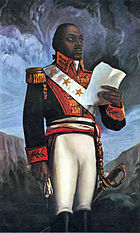Stono River Slave Rebellion Site
| North American slave revolts |
|---|
 Toussaint Louverture |
|
|
Stono River Slave Rebellion Site
|
|

Site where the rebellion began, 2013
|
|
| Nearest city | Rantowles, South Carolina |
|---|---|
| Built | 1739 |
| NRHP reference # | 74001840 |
| Significant dates | |
| Added to NRHP | May 30, 1974 |
| Designated NHL | May 30, 1974 |
The Stono Rebellion (sometimes called Cato's Conspiracy or Cato's Rebellion) was a slave rebellion that began on 9 September 1739, in the colony of South Carolina. It was the largest slave uprising in the British mainland colonies, with 25 white people and 35 to 50 black people killed. The uprising was led by native Africans who were likely from the Central African Kingdom of Kongo, as some of the rebels spoke Portuguese.
Their leader, Jemmy, was a literate slave. In some reports, however, he is referred to as "Cato", and likely was held by the Cato, or Cater, family who lived near the Ashley River and north of the Stono River. He led 20 other enslaved Kongolese, who may have been former soldiers, in an armed march south from the Stono River (for which the rebellion is named). They were bound for Spanish Florida. This was due to a Spanish effort to destabilize British rule, where they (the Spanish) had promised freedom and land at St. Augustine to slaves who escaped from the British colonies.
Jemmy and his group recruited nearly 60 other slaves and killed some whites before being intercepted and defeated by South Carolina militia near the Edisto River. A group of slaves escaped and traveled another 30 miles (50 km) before battling a week later with the militia. Most of the captured slaves were executed; the surviving few were sold to markets in the West Indies.
In response to the rebellion, the South Carolina legislature passed the Negro Act of 1740, which restricted slave assembly, education, and movement. It also enacted a 10-year moratorium against importing African slaves, because they were considered more rebellious, and established penalties against slaveholders' harsh treatment of slaves. It required legislative approval for each act of manumission, which slaveholders had previously been able to arrange privately. This sharply reduced the rate of manumissions in the state.
Since 1708, the majority of the population of the South Carolina colony was slaves, as importation of laborers from Africa had increased in recent decades with labor demand from the expansion of cotton and rice cultivation as commodity export crops. Historian Ira Berlin has called this the Plantation Generation, noting that South Carolina had become a "slave society," with slavery central to its economy. As planters had imported many slaves to satisfy the increased demand for labor, most slaves were native Africans. Many in South Carolina were from the Kingdom of Kongo, which had converted to Catholicism in the 15th century. Numerous slaves had first been held in the British West Indies, where they were considered to become 'seasoned' by working there under slavery, before being sold to South Carolina.
...
Wikipedia
